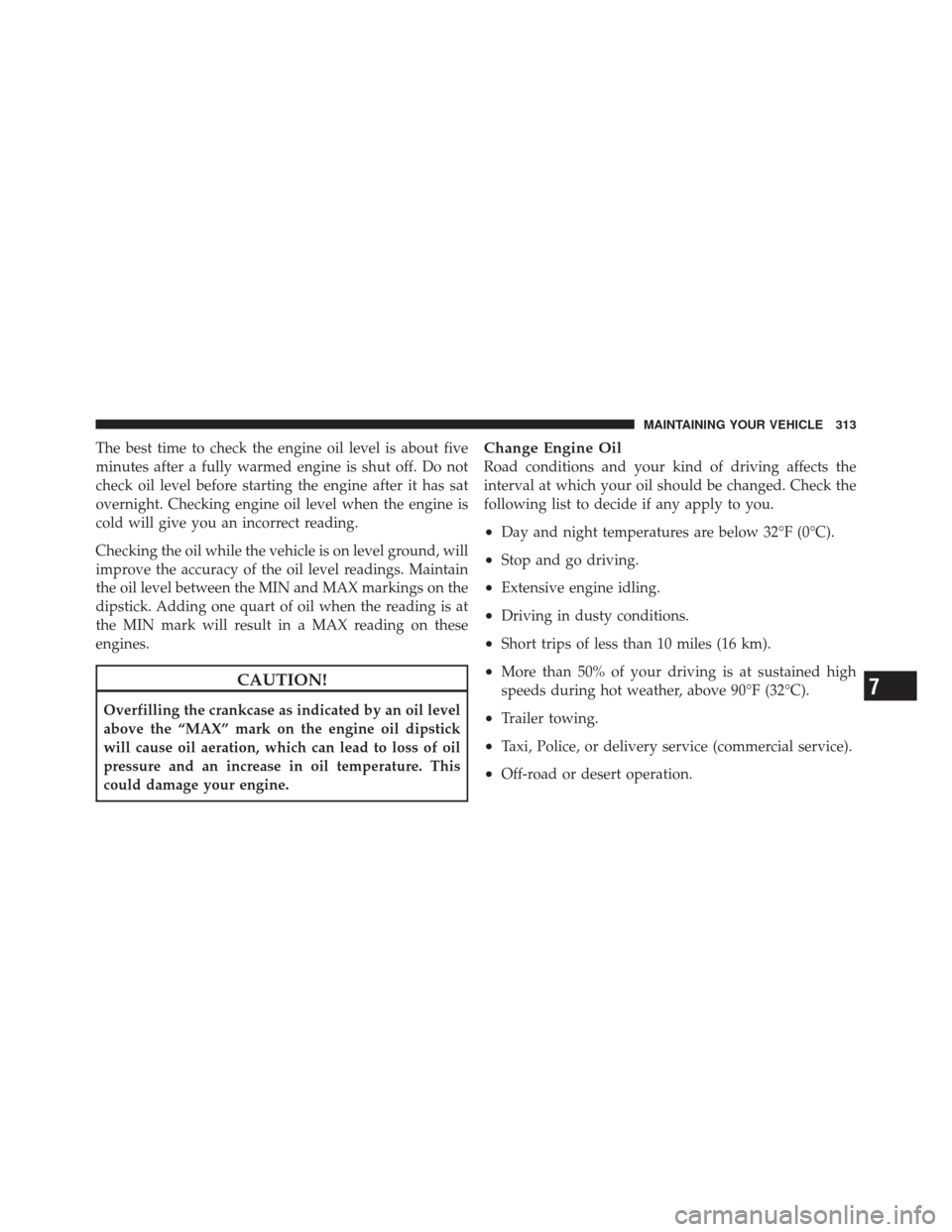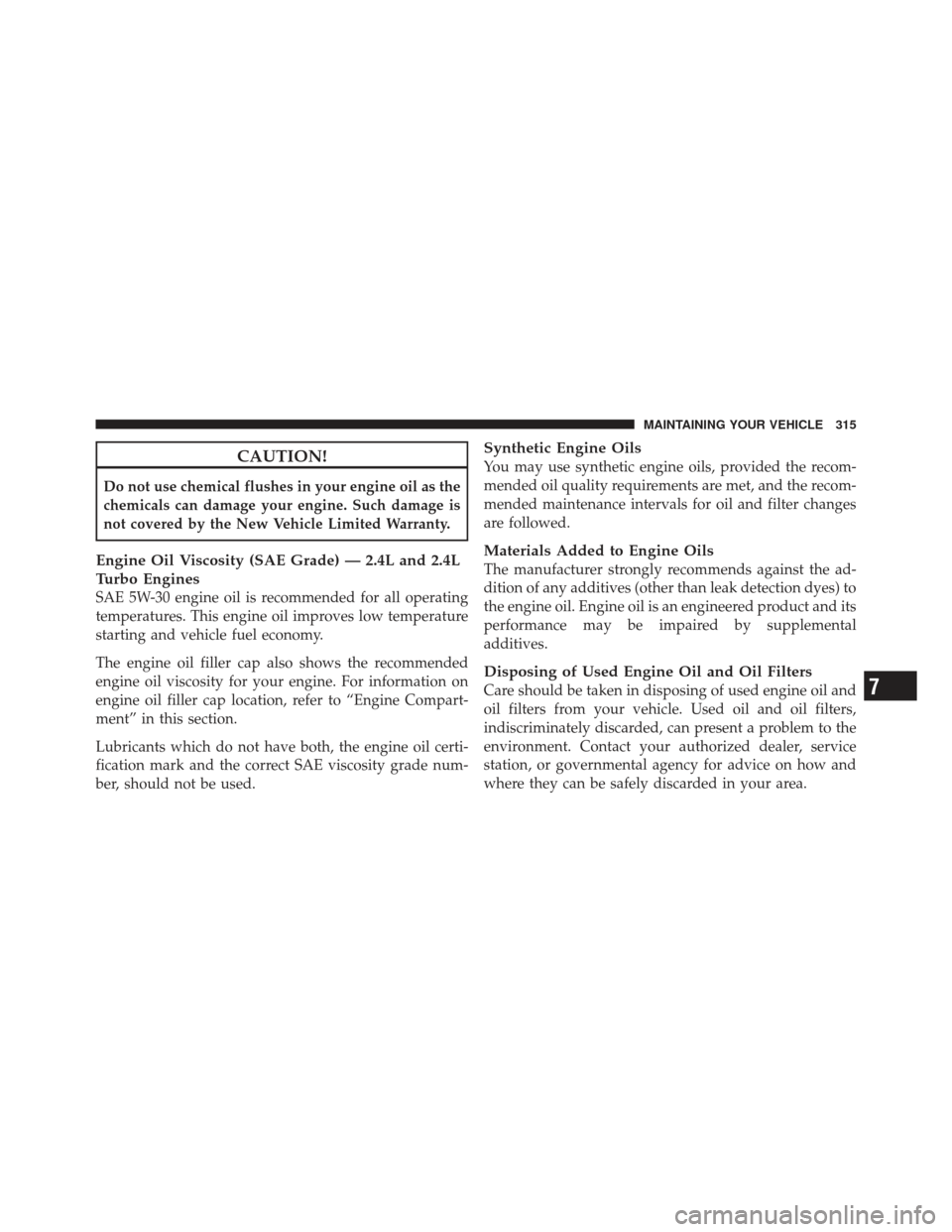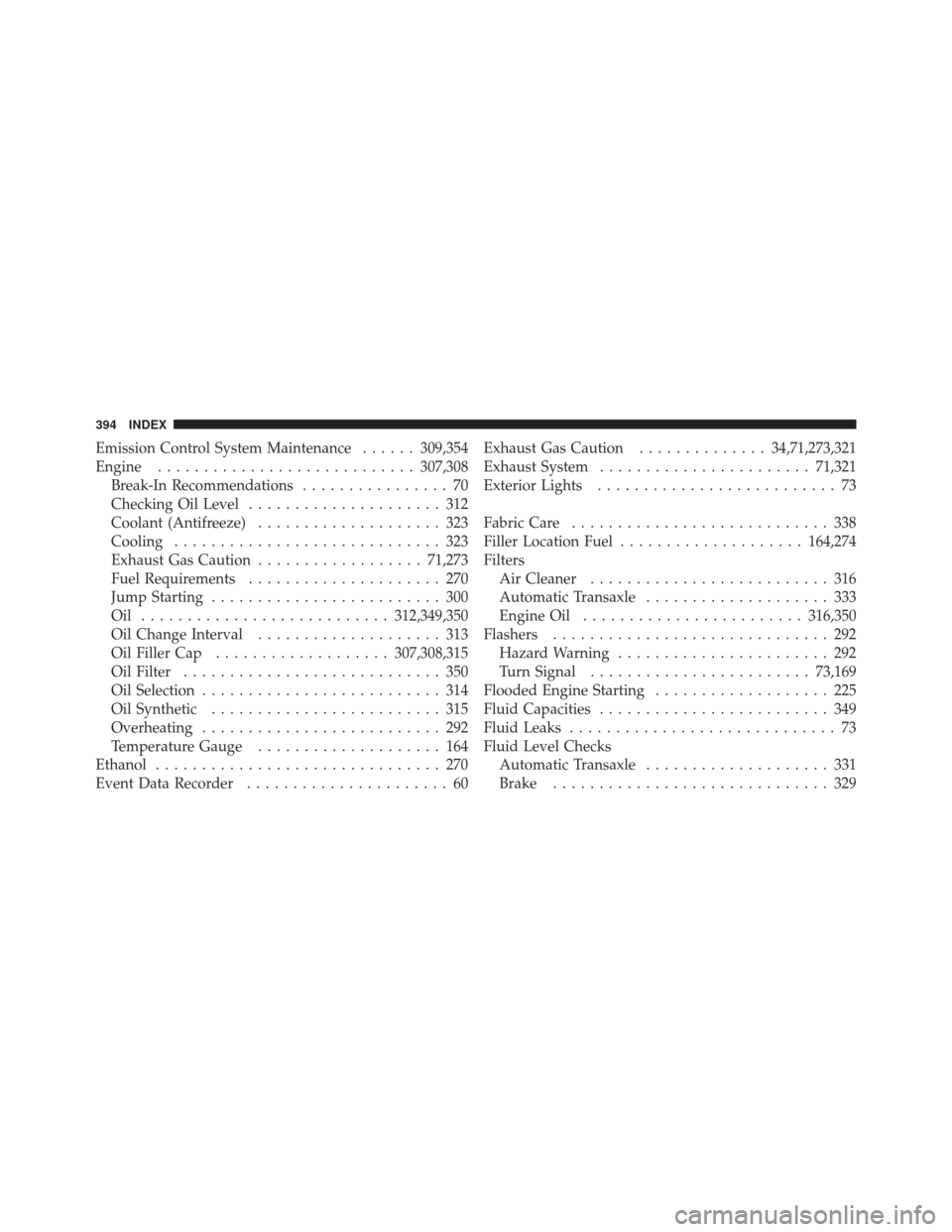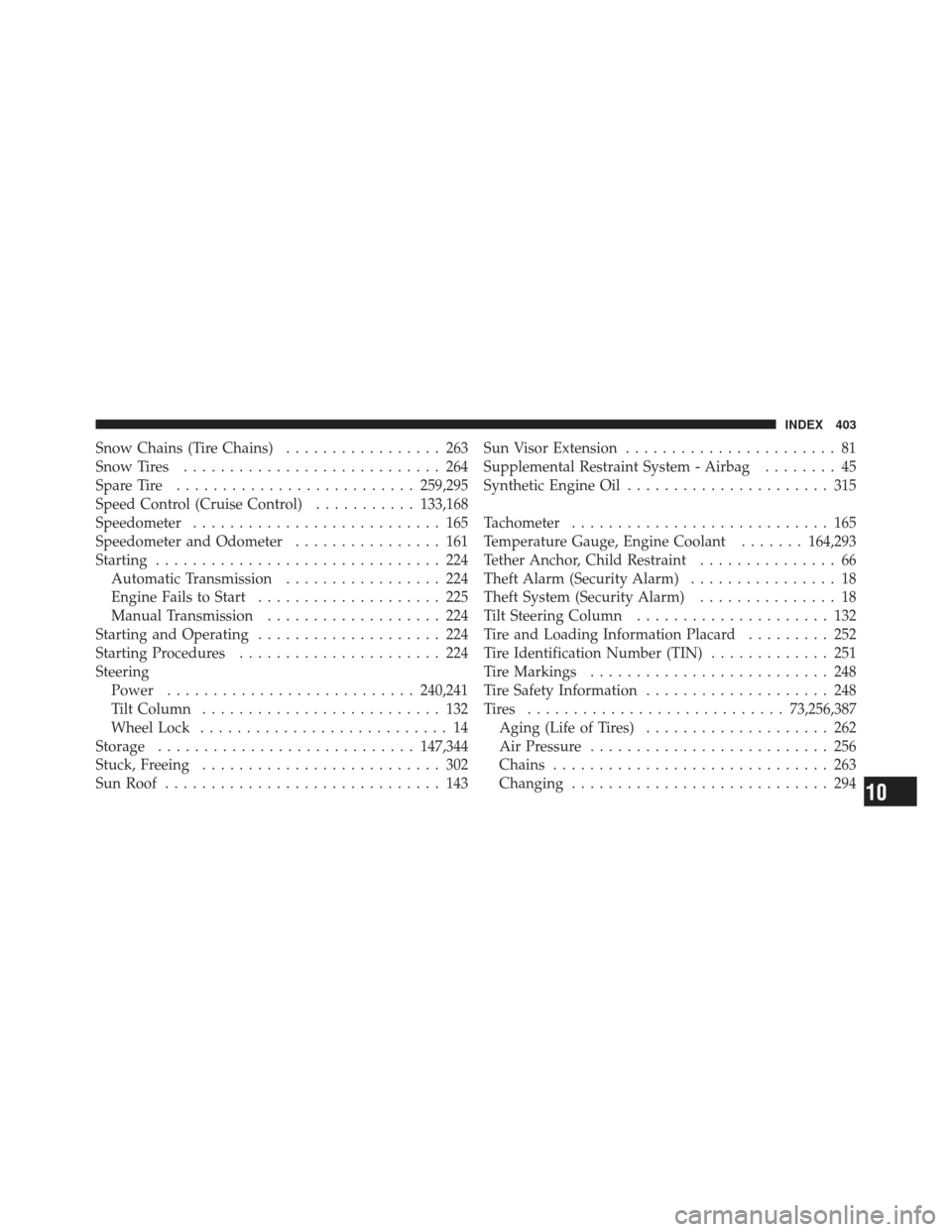oil temperature CHRYSLER PT CRUISER 2009 1.G Owners Manual
[x] Cancel search | Manufacturer: CHRYSLER, Model Year: 2009, Model line: PT CRUISER, Model: CHRYSLER PT CRUISER 2009 1.GPages: 410, PDF Size: 5.24 MB
Page 295 of 410

CAUTION!
Driving with a hot cooling system could damage
your vehicle. If the pointer of the Coolant Tempera-
ture Gage rises to the H (red) mark, the instrument
cluster will sound a chime. When safe, pull over and
stop the vehicle. Turn off the air conditioning and
wait until the pointer drops back into the normal
range. If the pointer remains on the H (red) mark for
more than a minute, turn the engine off immediately
and call for service.
NOTE: There are steps that you can take to slow down
an impending overheat condition:
•If your air conditioner (A/C) is on, turn it off. The A/C
system adds heat to the engine cooling system and
turning the A/C can help remove this heat.
•You can also turn the Temperature Control to maxi-
mum heat, the Mode Control to floor and the Fan
Control to high. This allows the heater core to act as a
supplement to the radiator and aids in removing heat
from the engine cooling system.
WARNING!
A hot engine cooling system is dangerous. You or
others could be badly burned by steam or boiling
coolant. You may want to call a service center if your
vehicle overheats. If you decide to look under the
hood yourself, refer to Section 7, Maintenance, of this
manual. Follow the warnings under the Cooling
System Pressure Cap paragraph.
6
WHAT TO DO IN EMERGENCIES 293
Page 315 of 410

The best time to check the engine oil level is about five
minutes after a fully warmed engine is shut off. Do not
check oil level before starting the engine after it has sat
overnight. Checking engine oil level when the engine is
cold will give you an incorrect reading.
Checking the oil while the vehicle is on level ground, will
improve the accuracy of the oil level readings. Maintain
the oil level between the MIN and MAX markings on the
dipstick. Adding one quart of oil when the reading is at
the MIN mark will result in a MAX reading on these
engines.
CAUTION!
Overfilling the crankcase as indicated by an oil level
above the “MAX” mark on the engine oil dipstick
will cause oil aeration, which can lead to loss of oil
pressure and an increase in oil temperature. This
could damage your engine.
Change Engine Oil
Road conditions and your kind of driving affects the
interval at which your oil should be changed. Check the
following list to decide if any apply to you.
•Day and night temperatures are below 32°F (0°C).
•Stop and go driving.
•Extensive engine idling.
•Driving in dusty conditions.
•Short trips of less than 10 miles (16 km).
•More than 50% of your driving is at sustained high
speeds during hot weather, above 90°F (32°C).
•Trailer towing.
•Taxi, Police, or delivery service (commercial service).
•Off-road or desert operation.
7
MAINTAINING YOUR VEHICLE 313
Page 317 of 410

CAUTION!
Do not use chemical flushes in your engine oil as the
chemicals can damage your engine. Such damage is
not covered by the New Vehicle Limited Warranty.
Engine Oil Viscosity (SAE Grade) — 2.4L and 2.4L
Turbo Engines
SAE 5W-30 engine oil is recommended for all operating
temperatures. This engine oil improves low temperature
starting and vehicle fuel economy.
The engine oil filler cap also shows the recommended
engine oil viscosity for your engine. For information on
engine oil filler cap location, refer to “Engine Compart-
ment” in this section.
Lubricants which do not have both, the engine oil certi-
fication mark and the correct SAE viscosity grade num-
ber, should not be used.
Synthetic Engine Oils
You may use synthetic engine oils, provided the recom-
mended oil quality requirements are met, and the recom-
mended maintenance intervals for oil and filter changes
are followed.
Materials Added to Engine Oils
The manufacturer strongly recommends against the ad-
dition of any additives (other than leak detection dyes) to
the engine oil. Engine oil is an engineered product and its
performance may be impaired by supplemental
additives.
Disposing of Used Engine Oil and Oil Filters
Care should be taken in disposing of used engine oil and
oil filters from your vehicle. Used oil and oil filters,
indiscriminately discarded, can present a problem to the
environment. Contact your authorized dealer, service
station, or governmental agency for advice on how and
where they can be safely discarded in your area.7
MAINTAINING YOUR VEHICLE 315
Page 396 of 410

Emission Control System Maintenance......309,354
Engine ............................ 307,308
Break-In Recommendations ................ 70
Checking Oil Level ..................... 312
Coolant (Antifreeze) .................... 323
Cooling ............................. 323
Exhaust Gas Caution .................. 71,273
Fuel Requirements ..................... 270
Jump Starting ......................... 300
Oil ........................... 312,349,350
Oil Change Interval .................... 313
Oil Filler Cap ................... 307,308,315
Oil Filter ............................ 350
Oil Selection .......................... 314
Oil Synthetic ......................... 315
Overheating .......................... 292
Temperature Gauge .................... 164
Ethanol ............................... 270
Event Data Recorder ...................... 60 Exhaust Gas Caution
..............34,71,273,321
Exhaust System ....................... 71,321
Exterior Lights .......................... 73
Fabric Care ............................ 338
Filler Location Fuel .................... 164,274
Filters Air Cleaner .......................... 316
Automatic Transaxle .................... 333
Engine Oil ........................ 316,350
Flashers .............................. 292
Hazard Warning ....................... 292
Turn Signal ........................ 73,169
Flooded Engine Starting ................... 225
Fluid Capacities ......................... 349
Fluid Leaks ............................. 73
Fluid Level Checks Automatic Transaxle .................... 331
Brake .............................. 329
394 INDEX
Page 405 of 410

Snow Chains (Tire Chains)................. 263
Snow Tires ............................ 264
Spare Tire .......................... 259,295
Speed Control (Cruise Control) ...........133,168
Speedometer ........................... 165
Speedometer and Odometer ................ 161
Starting ............................... 224
Automatic Transmission ................. 224
Engine Fails to Start .................... 225
Manual Transmission ................... 224
Starting and Operating .................... 224
Starting Procedures ...................... 224
Steering Power ........................... 240,241
Tilt Column .......................... 132
Wheel Lock ........................... 14
Storage ............................ 147,344
Stuck, Freeing .......................... 302
Sun Roof .............................. 143 Sun Visor Extension
....................... 81
Supplemental Restraint System - Airbag ........ 45
Synthetic Engine Oil ...................... 315
Tachometer ............................ 165
Temperature Gauge, Engine Coolant .......164,293
Tether Anchor, Child Restraint ............... 66
Theft Alarm (Security Alarm) ................ 18
Theft System (Security Alarm) ............... 18
Tilt Steering Column ..................... 132
Tire and Loading Information Placard ......... 252
Tire Identification Number (TIN) ............. 251
Tire Markings .......................... 248
Tire Safety Information .................... 248
Tires ............................ 73,256,387
Aging (Life of Tires) .................... 262
Air Pressure .......................... 256
Chains .............................. 263
Changing ............................ 294
10
INDEX 403